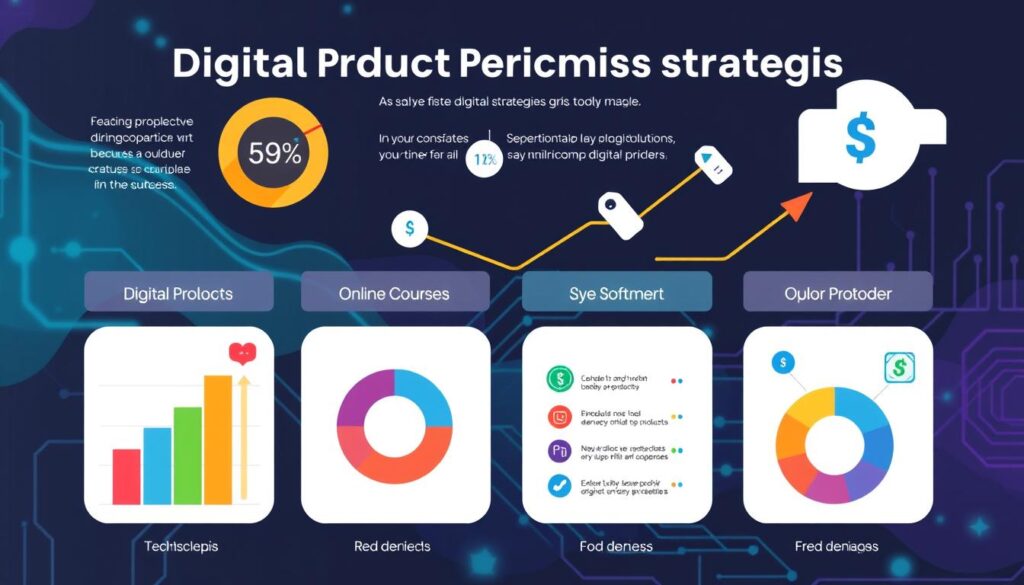As an entrepreneur, I’ve found that selling digital products is a great way to make money online. These products can earn you passive income and give customers valuable content. In this guide, I’ll show you 5 profitable digital products to sell online. You’ll get the tips and strategies you need to succeed in the digital market.
Key Takeaways
- Discover 5 lucrative digital product ideas to sell online and generate passive income.
- Understand the concept of digital goods and their unique benefits for online entrepreneurs.
- Explore a wide range of digital product categories, from online courses to digital templates.
- Learn how to create high-quality digital content and effectively market your products.
- Gain inspiration from successful case studies and expert insights on selling digital products.
What are Digital Products?
Digital products are things you can’t hold in your hand but can get online. Examples include ebooks, online courses, and software. They are easy to make, share, and grow, making them great for earning money without much work.
Understanding the Concept of Digital Goods
Digital goods are content or software you can get online. They don’t take up space like physical items do. This makes them easy to share and helps both the people making them and those buying them.
Benefits of Selling Digital Products Online
There are many good things about selling digital products online:
- Low Overhead: Making and sharing digital products doesn’t cost much. You don’t need to worry about making, storing, or shipping things.
- Scalability: You can sell digital goods as many times as you want without much extra work. This means you can make money even when you’re not working.
- Global Reach: The internet lets you sell to people all over the world. It’s easy to reach customers everywhere.
- Automated Delivery: Digital products can be sent out right away. This makes things easy for customers.
- Flexibility: You can change or add to digital products anytime. This helps keep your offerings fresh and interesting to customers.
Knowing how digital products work and their benefits can open up new chances for success. It’s a big part of the digital world’s growth and profit.
Digital Products to Sell Online
The digital world is full of chances for creators and sellers. You can sell everything from e-books and online courses to stock photos and music. This vast range of digital products can help you succeed online.
I’ve made a list of 5top digital products to sell online. Each type has its own audience and success stories. They show how you can connect with people all over the world.
- E-books – Share your knowledge or stories with readers everywhere. Examples: “The Ultimate Guide to Sustainable Living” and “Unraveling the Mysteries of the Multiverse”.
- Online Courses – Use your skills to teach others. Examples: “Mastering the Art of Digital Photography” and “Become a Python Programming Ninja”.
- Stock Photos and Graphics – Sell your photos and graphics to designers and marketers. Examples: “Ethereal Landscapes” and “Vintage Botanical Illustrations”.
- Design Templates – Offer templates for websites, social media, and presentations. Examples: “Minimalist WordPress Themes” and “Infographic Templates for Business”.
- Audio and Music Tracks – Sell music for videos, games, and more. Examples: “Zen Garden Ambiance” and “Upbeat Corporate Jingles”.
These are just a few ideas to start your online business. By exploring different digital products, you can use your creativity and skills to grow a global business.
“The beauty of digital products is that they can be replicated and distributed infinitely, allowing you to scale your business and maximize your earning potential.”
| Digital Product Category | Potential Target Audience | Examples |
|---|---|---|
| E-books | Readers, hobbyists, professionals | “The Ultimate Guide to Sustainable Living”, “Unraveling the Mysteries of the Multiverse” |
| Online Courses | Students, professionals, hobbyists | “Mastering the Art of Digital Photography”, “Become a Python Programming Ninja” |
| Stock Photos and Graphics | Designers, marketers, content creators | “Ethereal Landscapes”, “Vintage Botanical Illustrations” |
| Design Templates | Professionals, entrepreneurs, small businesses | “Minimalist WordPress Themes”, “Infographic Templates for Business” |
| Audio and Music Tracks | Multimedia creators, content producers, businesses | “Zen Garden Ambiance”, “Upbeat Corporate Jingles” |
How to Create and Sell Digital Products
Making and selling digital products can be very profitable. But, it needs a smart plan. I’ll show you how to pick a good niche and make digital content that people will love.
Choosing a Profitable Niche
First, pick a niche that can make money. Look for areas where people want digital products and where you know a lot. Think about the size of the market, how much competition there is, and if you can keep making money over time. Do lots of research to find the best chance to succeed.
Creating High-Quality Digital Content
After picking your niche, start making your digital products. Make content that helps your audience and meets their needs or interests. This could be e-books, online courses, or digital templates. Spend time making your content great, engaging, and easy on the eyes.
Success in digital products comes from making content that’s different and valuable. By following these steps, you can make and sell your own digital products that do well.
“The secret to creating successful digital products is to focus on solving real problems for your target audience.”
Best Platforms to Sell Digital Products
There are many platforms to sell digital products online. Each has its own features and benefits. It’s important to pick the right one for your business. Here, we’ll look at some top platforms for selling digital products.
Top Platforms for Selling Digital Products
- Gumroad – Known for its easy-to-use interface and strong tools, Gumroad is great for creators. It supports a wide range of digital products, like ebooks and software.
- Sellfy – Sellfy offers a smooth shopping experience. It’s perfect for selling digital downloads and subscriptions. It’s also good for small to medium-sized businesses.
- Etsy – While famous for handmade items, Etsy also has a big market for digital products. It’s a great place for creatives to sell their work.
- Creative Market – This platform is for designers and creatives. It’s the best place to sell high-quality digital assets like fonts and graphics.
| Platform | Key Features | Suitability |
|---|---|---|
| Gumroad | User-friendly interface, robust digital product management tools | Wide range of digital products, from ebooks and courses to graphics and software |
| Sellfy | Seamless e-commerce experience, supports digital downloads, subscriptions, and physical products | Small to medium-sized businesses selling digital products |
| Etsy | Large marketplace with a focus on handmade and vintage items, also hosts digital products | Creatives and designers looking to reach a wide audience |
| Creative Market | Designed for the design and creative community, specializes in digital assets like fonts, graphics, and themes | Digital product creators in the design industry |
Choosing the right platform is key to selling digital products online. Think about your audience, the products you sell, and the platform’s features. The right platform can help you sell more and grow your business.
“The key to success in selling digital products online is finding the right platform that aligns with your business and target audience.”
Marketing Strategies for Digital Products
As a digital product entrepreneur, having a good marketing strategy is key to success. I’ll explore two strong marketing methods: content marketing and social media marketing. These can help you draw in, keep, and turn potential buyers into customers.
Content Marketing and SEO
Content marketing is a great way to promote your digital products. By making and sharing valuable, relevant, and interesting content, you can show your brand’s expertise. This builds trust with your audience and can lead to more sales.
Writing high-quality blog posts, video tutorials, and webinars can help you rank better in search engines. This makes it easier for people to find your digital products.
SEO is also crucial for your content marketing. By using the right keywords, meta tags, and other SEO tips, your content becomes more visible. This helps more people find your digital products.
Social Media Marketing
Social media is a powerful tool to connect with your audience and promote your digital products. Using platforms like Facebook, Instagram, Twitter, and LinkedIn can help you grow your brand. It also lets you engage with customers and drive traffic to your products.
Creating a smart social media marketing plan is key. This includes making engaging content, running ads, and working with influencers. It’s a great way to reach more people and boost sales.
| Marketing Strategy | Key Benefits |
|---|---|
| Content Marketing and SEO | Establish brand authority Improve search engine visibility Attract and engage target audience |
| Social Media Marketing | Build brand awareness and engagement Reach a wider audience Drive traffic and sales to digital products |
“Effective marketing is the lifeblood of a successful digital product business.”
Pricing and Monetization of Digital Products
Figuring out the right price and ways to make money from your digital products is key to your online business’s success. As you start to price digital products, monetize digital products, and look at different revenue models for digital products, think carefully. This will help make sure your products are profitable and can keep going.
First, think about what makes your digital products special. What do they offer that others don’t? And how much are people willing to pay for them? Doing market research and looking at what’s happening in your industry can help you set prices that match what people think your products are worth.
Next, pick the best way to make money from your digital products. There are a few common ways:
- One-time purchases: Selling your digital products once for a set price.
- Subscriptions: Letting people pay a monthly or yearly fee for ongoing access to your content or services.
- Freemium: Giving away a basic version of your product for free, but offering more for those who pay.
- Bundles: Selling a group of related digital products together at a lower price.
When picking a way to make money, think about who you’re selling to, what your products are, and what others are doing. Trying out different prices and ways to make money can help you find what works best for you.
| Pricing Strategy | Potential Benefits | Potential Drawbacks |
|---|---|---|
| One-Time Purchases | Simplicity, predictable revenue, and better cash flow | Limited ongoing revenue and potential for customer churn |
| Subscriptions | Recurring revenue, improved customer retention, and opportunities for upselling | Potential customer resistance, increased customer acquisition costs |
| Freemium | Attract a larger customer base, opportunity to convert free users to paid | Difficulty in monetizing free users, potential for cannibalizing paid offerings |
| Bundles | Increased perceived value, cross-selling opportunities, and potential for higher average order value | Complexity in pricing and managing multiple products |
In the end, the pricing and monetization plan you choose should fit your digital products, who you’re selling to, and your business goals. Try different things, listen to what your customers say, and be ready to change your plan as your business grows.
“The key to successful pricing of digital products is finding the sweet spot between perceived value and customer willingness to pay.”
Digital Products and the Future of Online Business
The digital world is changing fast, and online business is set to be shaped by new digital products. We’ll see more interactive e-books, subscription learning platforms, AI tools, and virtual experiences. These changes could really change how we work, learn, and enjoy content.
There’s a big trend towards personalized digital products. People want things that fit their unique needs and tastes. Digital products can offer this by using advanced analytics and machine learning. This makes for a more engaging and loyal user base.
Emerging tech like AR and VR is also becoming key in digital products. These technologies can take users on new adventures, mixing the real and digital worlds. As they get easier to use, we’ll see more exciting digital products that offer unique experiences.
The subscription model is also growing, affecting digital products a lot. More people are choosing subscriptions for ongoing value and ease. Digital creators can tap into this by offering ongoing access to tools, resources, or content. This builds strong customer relationships and steady income.
As online business evolves, digital products will play a bigger role. By keeping up with trends, using new tech, and focusing on personal and engaging experiences, creators can thrive in the future.
| Trend | Impact on Digital Products |
|---|---|
| Personalization | Increased demand for customized and tailored digital experiences |
| Emerging Technologies | Integration of AR, VR, and other immersive technologies to create captivating digital products |
| Subscription Economy | Rise of subscription-based digital product models offering ongoing value and convenience |
By embracing these trends and creating innovative, user-focused digital products, businesses can succeed in the changing online market.
Successful Case Studies and Inspiration
Starting your journey in creating and selling digital products? It’s key to learn from others’ success. I’m excited to share stories of entrepreneurs who’ve made it big by selling valuable digital goods online.
Sarah, a freelance graphic designer, started selling custom logo templates and design assets on Etsy and Creative Market. She focused on quality and demand, building a loyal customer base. Now, she earns passive income from home.
Mike, an online educator, created courses teaching software skills. He scaled his business, reaching students globally. This way, he earns a lot without the limits of a classroom.
| Entrepreneur | Digital Product | Platform | Annual Revenue |
|---|---|---|---|
| Sarah | Custom logo templates and design assets | Etsy, Creative Market | $85,000 |
| Mike | Online courses teaching software skills | Udemy, Teachable | $120,000 |
These stories show the huge potential of digital products online. By finding a profitable niche and marketing well, entrepreneurs have built successful businesses. Their success proves the power of digital products for online entrepreneurs.
“The beauty of digital products is that they can be sold and delivered instantly, without the need for physical inventory or shipping. This makes them a highly scalable and lucrative business model.”
As you delve into the digital product world, I hope these stories inspire and guide you. They can help you create your own successful digital venture.
The Pros and Cons of Selling Digital Products
Exploring digital products can be both thrilling and profitable. Yet, it’s crucial to consider both sides before diving in. As a copywriting journalist, I aim to give you a fair view of the ups and downs of digital product sales.
One major pro is the scalability of digital products. They can be made and shared endlessly, reaching people worldwide without big costs. This can make your business very profitable, as each sale adds to your earnings.
Another big advantage is the low overhead. You don’t have to deal with inventory, shipping, or storage. This cuts down your costs, letting you focus on making great digital content and marketing.
But, there are also cons to think about. One is the risk of intellectual property theft. Digital content can be copied and shared easily, making it hard to protect your work. Strong security and copyright laws are key to fighting this issue.
Also, offering customer support for digital products can be tricky. Customers might face tech issues or have questions, needing a quick and knowledgeable support team.
| Pros of Selling Digital Products | Cons of Selling Digital Products |
|---|---|
| Scalability | Intellectual Property Infringement |
| Low Overhead | Customer Support Challenges |
| Global Reach | Potential for Saturation in the Market |
| Passive Income Potential | Difficulty in Differentiating Your Products |
It’s vital to think through these pros and cons before deciding. The benefits are enticing, but the challenges are real. By weighing these, you can make a smart choice that fits your business goals and boosts your success in the digital world.
Conclusion
We’ve explored the world of digital products, and I hope you now see their huge potential. They can help you build a successful online business. Digital products are versatile and offer many benefits, leading to financial freedom and success.
Digital products are a great choice for anyone wanting to start or grow a business. They are affordable, scalable, and profitable. By finding the right niche, creating quality content, and using effective marketing, you can make a lot of money.
Now, it’s time to start your journey with digital products. Whether you’re new or looking to grow, the advice in this article will guide you. Stay open to change and new ideas in the digital world. With hard work and a clear plan, you can master digital products.
FAQ
What types of digital products can I sell online?
You can sell ebooks, online courses, and digital art. Software, music, and stock photos are also popular. Templates and digital tools are great too.
What are the benefits of selling digital products?
Selling digital products is cost-effective and scalable. You can earn passive income and reach people worldwide. They’re easy to make, update, and share.
How do I choose a profitable niche for my digital products?
Pick a niche you know well and are passionate about. Look at the demand and your audience’s needs. Create products that solve their problems.
What platforms are best for selling digital products?
Top platforms include Gumroad, Teachable, and Podia. Thinkific and Sellfy are also great. They offer secure payments, delivery, and marketing tools.
How can I effectively market my digital products?
Use content marketing, SEO, and social media. Email marketing is key to engaging your audience.
How should I price my digital products?
Consider value, costs, and your audience. Try different pricing models. Find what works best for your customers.
What are some common challenges of selling digital products?
Watch out for intellectual property issues and customer support. Keep offering new products to keep customers interested.







